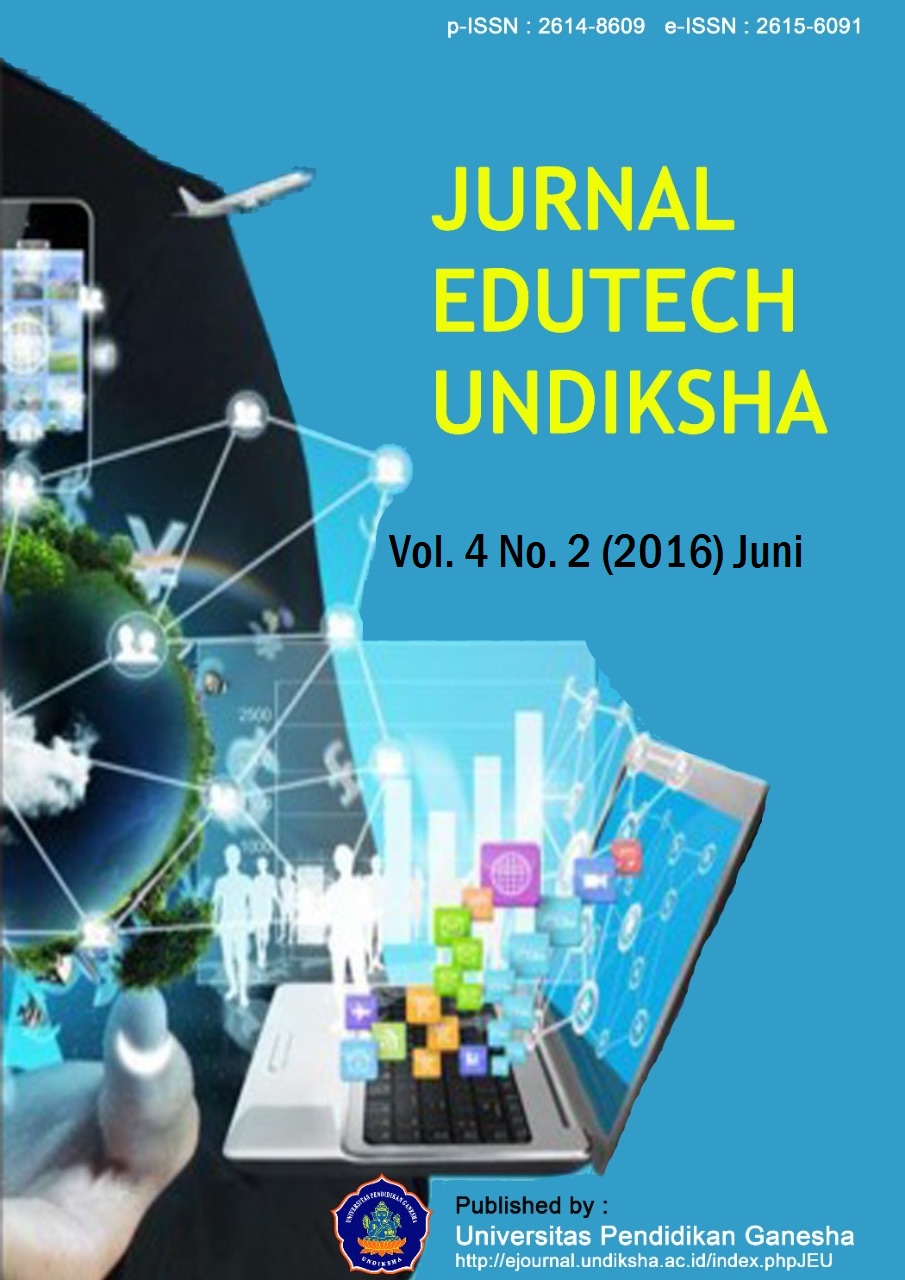PENGEMBANGAN MULTIMEDIA PRESENTASI IPA DENGAN MODEL LUTHER KELAS IV SEMESTER GENAP DI SD NEGERI 1 KALIUNTU
DOI:
https://doi.org/10.23887/jeu.v4i2.7728Abstract
Penelitian ini bertujuan untuk (1) mendeskripsikan rancang bangun multimedia presentasi mata pelajaran IPA, (2) mengetahui kualitas multimedia presentasi menurut review ahli, dan uji coba yang dilakukan siswa, dan (3) mengetahui efektivitas multimedia presentasi mata pelajaran IPA. Penelitian ini adalah penelitian pengembangan. Penelitian pengembangan ini menggunakan model Luther. Validasi multimedia dilakukan oleh ahli isi mata pelajaran, ahli desain pembelajaran, ahli media pembelajaran, uji coba perorangan, uji coba kelompok kecil, dan uji coba lapangan. Efektivitas multimedia dilakukan oleh 29 siswa menggunakan desain penelitian pre-test dan post-test. Data dikumpulkan dengan metode wawancara, pencatatan dokumen, kuesioner dan tes objektif. Analisis data menggunakan analisis deskriptif kualitatif, kuantitatif dan statistik inferensial/induktif uji-t. Hasil penelitian ini adalah (1) rancang bangun pengembangan multimedia presentasi mulai dari langkah konsep, perancangan, pengumpulan bahan, pembuatan, uji coba, dan distribusi; (2) kualitas hasil pengembangan media menurut review ahli dan siswa yaitu: a) ahli isi pembelajaran 94% berada pada kategori sangat baik; b) ahli desain pembelajaran 85% berada pada kategori baik; c) ahli media pembelajaran 89% berada pada kategori baik; d) uji coba perorangan 92% berada pada kategori sangat baik; e) uji coba kelompok kecil 92% berada pada kategori sangat baik; f) uji coba lapangan 93% berada pada kategori sangat baik; (3) berdasarkan uji hipotesis ditunjukkan bahwa harga thitung =14,10 > ttabel =2,003. Jadi harga t hitung lebih besar daripada harga t tabel. Ini berarti terdapat perbedaan signifikan pada hasil belajar siswa sebelum dan sesudah menggunakan Multimedia presentasiKata Kunci : pengembangan, multimedia presentasi, IPA
This study aimed to (1) describe the design of multimedia presentations in science subjects, (2) know the quality of multimedia presentations according to the expert review, and tests conducted on the students, and (3) know the effectiveness of multimedia presentation science subjects. This study is a developmental research. Research using the model of development of Luther. Validation is done by skilled multimedia course content, instructional design experts, media expert learning, individual testing, piloting small groups, and field trials. Multimedia effectiveness conducted by 29 student research design of pre-test and post-test. Data were collected by interviews, recording documents, questionnaires and objective tests. Analysis of data using qualitative descriptive analysis, quantitative and inferential/inductive t-test. The results of this study were (1) design multimedia development starting from step presentations the concept, design, collection of materials, manufacture, testing, and distribution; (2) the quality of the development of media according to the review expert and student: a) expert learning content 94% are in the very good category; b) 85% of instructional design experts are in both categories; c) 89% of instructional media experts are in both categories; d) 92% individual testing are in very good category; e) small group trial 92% are in the very good category; f) field trials 93% are in the very good category; (3) based on the hypothesis testing indicated that the price of t = 14.10> table = 2.003. Therefore t count is higher than t table. This means that there is a significant difference in student learning outcomes before and after using multimedia presentations.
keyword : development, multimedia presentations, natural science
Published
2016-07-21
How to Cite
., I. M. G., ., D. I. N. J., & ., L. P. P. M. S. M. (2016). PENGEMBANGAN MULTIMEDIA PRESENTASI IPA DENGAN MODEL LUTHER KELAS IV SEMESTER GENAP DI SD NEGERI 1 KALIUNTU. Jurnal Edutech Undiksha, 4(2). https://doi.org/10.23887/jeu.v4i2.7728
Issue
Section
Articles
License
Authors who publish with the Jurnal Edutech Undiksha (JEU) agree to the following terms:
- Authors retain copyright and grant the journal the right of first publication with the work simultaneously licensed under an Attribution-ShareAlike 4.0 International (CC BY-SA 4.0) that allows others to share the work with an acknowledgment of the work's authorship and initial publication in this journal.
- Authors are able to enter into separate, additional contractual arrangements for the non-exclusive distribution of the journal's published version of the work (e.g., post it to an institutional repository or publish it in a book), with an acknowledgment of its initial publication in this journal.
- Authors are permitted and encouraged to post their work online (e.g., in institutional repositories or on their website) prior to and during the submission process, as it can lead to productive exchanges, as well as earlier and greater citation of published work. (See The Effect of Open Access)








